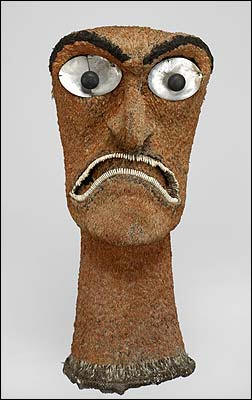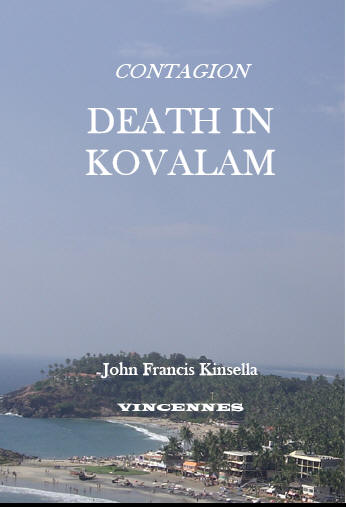| Read
BOOKS, TRAVELS and INTERNET. See our new INYT
sections devoted to books, travel and internet
sites. |

|
This exhibition gathers together more
than 250 works of Polynesian art from
the 18th and 19th centuries, from the
collections of the great European
museums but which are rarely exhibited:
astonishing divine images, ivory
ornaments, war bonnets, decorated
textiles… The exhibition therefore
explores the Pacific Islands at the time
of their first contact with European
travellers, missionaries and colonists.
Before coming to the Musée du quai
Branly, the exhibition was shown at the
Sainsbury Centre for Visual Arts and
then at the British Museum under the
name “Pacific Encounters”. The
Polynesian Islands (from the Greek polys
and nesos: “many islands”) were first
explored 3000 years ago by the first
travellers to venture east from the
Western Pacific. In the 18th century,
the entire region of the “Polynesian
Triangle” (composed of Hawaii, the
Easter Islands and New Zealand) had long
been inhabited by the Polynesian people
who shared the same roots. Art and
Divinity in Polynesia is the most
comprehensive exhibition to date on
Polynesian art: it
is the first time such a large number of
objects have been gathered together in
an exhibition. These rare pieces – made
from precious materials, such as
feathers, ivory, nephrite and pearl –
played important roles in the cultural
and religious life of the Polynesian
people between 1760-1860. The
exhibition explains the role of these
objects in their original context,
celebrates the creativity of the people
who created them and informs the visitor
about the history of the collections
from which they are taken. There were
many types of these encounters.
Wherever they went, the Polynesian
people always adapted to the different
environments and materials they
encountered. They also met other
Polynesian people with whom they became
allies or in whom they saw a potential
enemy. Valuable objects were made and
exchanged with the goal of establishing
and maintaining important
relationships –
between family groups, between chiefs,
and between mankind and the gods.
Between 1760 and 1860, Polynesia’s
cultural landscape fundamentally
changed. Before 1760, there was regular
contact between the Polynesian people on
different islands. They ignored Europe,
metal, firearms and Western religion.
With the arrival of the first boats from
the West, most of the Polynesian Islands
built a colonial, or pre-colonial,
relationship with the European powers.
In less than a century the majority of
the Polynesian people had suffered
various epidemics and had been converted
to one of the competing forms of
Christianity. However, paradoxically,
strong Polynesian cultural identities
survived and further developed. Art and
Divinity in Polynesia concentrates on
this turbulent period, from 1760 to
1860: a period of contact with European
navy officers, crew members, traders,
whalers, missionaries, travellers,
colonists, administrators and artists,
in fact with all types of Europeans for
whom fate had brought them to Polynesia.
Relations with these visitors were, for
the most part, conducted via the
intermediary of objects and materials
which travelled in both directions.
|
|
|
|
SUMMER READING John Francis
Kinsella's latest novel, Death in
Kovalam, takes place in
India where Tom
Barton, a City mortgage broker, arrives
in Kovalam, Kerala after abandoning his
business in the wake of the subprime
crisis. In his luxury hotel he meets
Emma, the wife of Stephen Parkly, the
CEO of a London bank, West Mercian
Finance. Stephen Parkly falls gravely
ill with a mysterious infection and is
hospitalized in a local clinic.
|

|
The disease is diagnosed as
cholera, panic sets in when tourists start to
fall ill with the deadly infection, just as the
tourist season is getting into the full swing of
the festive season. |
|
|
|
|
|
French
President Nicolas Sarkozy greets Barack Obama on his one day trip to Paris after
his Middle East tour. |
|
First
Priority Bank fails in Florida |
 |
|
First Priority becomes eighth
bank failure this year. Insured deposits of small
Florida bank will be assumed by SunTrust - First
Priority Bank was shut down by regulators on
Friday, making the small Florida lender the
eighth bank failure in the U.S. so far this
year. SunTrust Banks agreed to take on the
deposits of First Priority, the Federal Deposit
Insurance Corporation said in a statement late
Friday. The six branches of First Priority will
reopen on Monday as branches of SunTrust. |
|
On
the eve of the Olympics China vetoes
Zimbabwe sanctions |
|
 |
| Russia and
China wielded their veto to kill a
resolution imposing UN sanctions on
President Mugabe and his inner circle in
a defining vote in the 15-nation
council. Another shameful act of
political self interest by so called
great powers, in fact totalitarian
states. |
|
|
|
|
Radovan Karadzic to be
tried |
 |
|
Radovan Karadzic has
said a "media
witch-hunt" means he
will not receive a
fair trial at a UN
war crimes tribunal.
The former Bosnian
Serb leader wrote to
the tribunal saying
he has already been
branded a war
criminal by the
press, making an
acquittal
"unimaginable". Mr
Karadzic, who faces
11 counts of war
crimes including
genocide, also
claims he made an
immunity deal with
the US. Richard
Holbrooke, who
negotiated the
accord that ended
the Bosnian war,
told the BBC: "There
was never any deal."
Mr Karadzic referred to an alleged deal made with Mr Holbrooke, the
former US ambassador
to the United
Nations, for him to
withdraw from public
life. |
|
NASA
CELEBRATES
50 TEARS OF
SPACE |

|
Some
good
news
of
human
achievement
-
Nasa
is
celebrating
50
years
of
space
exploration
-
which
has
taken
the
American
space
agency
up
into
the
Earth's
orbit,
on
to
the
Moon,
and
deep
into
our
Solar
System.
That
journey
has
produced
many
iconic
images
-
from
the
Apollo
moon
landings,
to
the
space
shuttle
missions,
and
the
colourful
pictures
beamed
back
from
the
Hubble
Space
Telescope.
BBC
Slide
show
link |
|
|
|
THE CRASH - DOOM
OR HYPE? |
|
|
|
|
 |
|
Last month
the spacecraft uncovered a
bright white layer just two
inches below the surface, which
disappeared four days after it
was exposed to sunlight, leading
scientists to believe it was
ice. After examining a soil
sample from a trench
approximately two inches deep,
the claim has been confirmed. In
a Nasa statement, William
Boynton of the University of
Arizona said: “We have water.
“We’ve seen evidence for this
water ice before in observations
by the Mars Odyssey orbiter and
in disappearing chunks observed
by Phoenix last month, but this
is the first time Martian water
has been touched and tasted.”
Phoenix principal investigator
Peter Smith, of the University
of Arizona, said: “Mars is
giving us some surprises. “We’re
excited because surprises are
where discoveries come from.”
Scientists will now begin asking
whether the frozen water could
have been liquid at some point
in the planet’s history, which
would have created an
environment in which life could
have evolved. Experts believe
that if life ever existed on
Mars, it could still survive
today in isolated pockets
beneath the soil. Nasa has plans
to send astronauts to Mars after
returning humans to the moon in
2020. The Phoenix spacecraft
landed on the Martian surface on
May 25 for its three-month
mission. Since touching down, it
has been analyzing the
atmosphere and the soil, taking
pictures of the surface and
digging a number of trenches.
|
|
|
|
|
 |
|
Russian
scientists say
they have broken
the world record
for the deepest
dive in a body
of fresh water,
plumbing the
depths of Lake
Baikal in
Siberia.
Russian news
reports said two
manned
mini-submarines
successfully
plunged 1,680m
(5,512ft) to the
lake's bed. The
mini submarines
were built in
Finland at the
begining of
the nineties
during the time
of the USSR and
the editor of
INYT visited
these many times
in the Rauma
workshops in
Pori. The
mission is part
of a two-year
plan aimed at
conserving the
ecosystem of
Lake Baikal,
which contains
about one-fifth
of the world's
fresh water. The
area was
declared a
Unesco World
Heritage site in
1996.
Russia's Interfax and Itar-Tass news agencies cited expedition
organizers as
saying that the
Mir I and Mir II
mini-submarines
had touched the
bottom of the
lake. "This is a
world record for
a submarine
diving in fresh
water," Interfax
quoted an
organizer as
saying. However,
the Russian team
say they are
still awaiting
official
confirmation of
the depth of the
dive. The Mir
capsules are
already in the
record books for
their undersea
expeditions -
descending to
depths greater
than 4,000m and
were tested in
the Antartic
region after
they were
delivered to the
USSR.
|
|
 |
|
Well at least in Zimbabwe |
|
Zimbabwe's central bank has
revalued its currency in an
effort to control the effects of
hyperinflation.
The
bank is striking ten zeros off
Zimbabwe dollar bank notes,
making 10bn dollars now equal to
one dollar. |
|
 |
|
The
Independent New York Times will be pleased to
receive your articles and comments. Please
contact our editorial desk at the following
address
sumpinein@gmail.com
and we shall endeavor to answer you promptly. |
|
Maori
leader signs historic agreement |

| Maori tribal
leader Tama Iti signs a agreement with
the New Zealand government in
Wellington, signaling the beginning of
negotiations over land and sovereignty. |
|
|